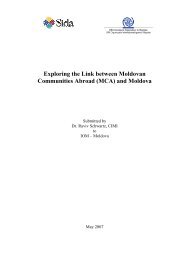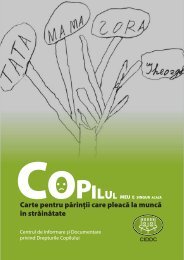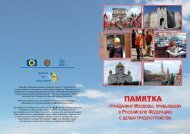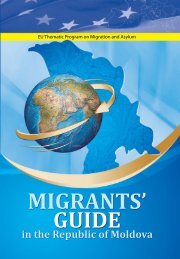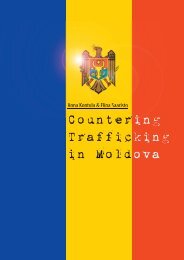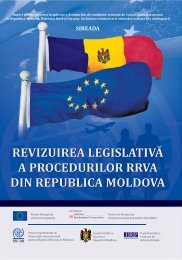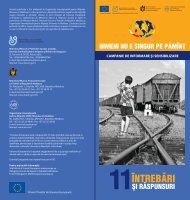Trafficking in Human Beings in Southeastern Europe - Iom
Trafficking in Human Beings in Southeastern Europe - Iom
Trafficking in Human Beings in Southeastern Europe - Iom
- No tags were found...
You also want an ePaper? Increase the reach of your titles
YUMPU automatically turns print PDFs into web optimized ePapers that Google loves.
<strong>Traffick<strong>in</strong>g</strong> <strong>in</strong> <strong>Human</strong> Be<strong>in</strong>gs<strong>in</strong> <strong>Southeastern</strong> <strong>Europe</strong>are conv<strong>in</strong>ced that they themselves are crim<strong>in</strong>als (and can be charged withprostitution, illegal work, illegal border cross<strong>in</strong>g, etc). They are, therefore,afraid of the police, and when asked, answer that they are not trafficked. Thesewomen are often too frightened or traumatised to communicate with the policeor are unaware that they can ask for assistance - especially when they arequestioned <strong>in</strong> the bar, <strong>in</strong> front of the owner, and <strong>in</strong> the presence of other people.Women, who have been taught not to trust the police, are conv<strong>in</strong>ced thatthey are the ones who have committed a crime and are afraid of their bosses,do not want to reveal any <strong>in</strong>formation and to <strong>in</strong>crim<strong>in</strong>ate themselves.Victim Referraland AssistanceSystem andGaps There<strong>in</strong>Girls under 18 are a special group - even if their transportation and work <strong>in</strong>the country of dest<strong>in</strong>ation was arranged with their consent, and not by forceor deceit, they must still be recognised as victims and provided with assistance.65% of Trafficked women and girls are not identified and referred forassistanceObstacles• Lack of guidel<strong>in</strong>es or procedures foridentify<strong>in</strong>g all victims of traffick<strong>in</strong>g,accord<strong>in</strong>g to Palermo Def<strong>in</strong>ition.• No procedure for identify<strong>in</strong>g womenwith legal documents as trafficked.• Girls under 18 pass as adults.• No procedure for children under 18.• Police only <strong>in</strong>volved <strong>in</strong> identification.• Victim’s lack of awareness of their ownsituation and of traffick<strong>in</strong>g.• Victim’s fear of police, traffickers andconsequences of illegal stay and work <strong>in</strong>sex <strong>in</strong>dustry.• Lack of assistance/services for victimsnot will<strong>in</strong>g to return home.• Women are blackmailed by the police totestify, and are refused support if theydo not agree to cooperate with thepolice.Remedies• Standardised procedures for identificationof both adults and children (basedon Palermo Protocols), with writtenguidel<strong>in</strong>es.• Independent agency do<strong>in</strong>g assessment ofthe situation and identification of the victims(NGOs, social workers, etc.).• Tra<strong>in</strong><strong>in</strong>g for the police, NGOs and otheragencies <strong>in</strong>volved <strong>in</strong> the process of identification.• Time and safe space for women tounderstand situation and their rights andto consider available options.• Monitor<strong>in</strong>g and evaluation for system ofidentification.2.2. AssistanceGenerally, it can be stated that as a result of the organisation, or lack of organisationof the identification and referral system, not more than 35 percent oftrafficked persons are recognised as such and receive assistance <strong>in</strong> the countriesof dest<strong>in</strong>ation and transit.In the countries of dest<strong>in</strong>ation, IOM <strong>in</strong>terviews women referred to them, organisestemporary accommodation, travel documents and safe return to theircountry of orig<strong>in</strong>. All women and girls who are part of the IOM assistance programmeare sent back home. A “victim’s profile” is sent by IOM to the traffickedperson’s home country where local NGOs or IOM offices offer furtherassistance. In the shelter, women and girls undergo a medical exam<strong>in</strong>ation,<strong>in</strong>clud<strong>in</strong>g a gynaecological exam<strong>in</strong>ation. Usually, as part of the IOM re<strong>in</strong>tegrationassistance, women and girls receive US$50 upon leav<strong>in</strong>g the country ofdest<strong>in</strong>ation and further US$100 <strong>in</strong> two <strong>in</strong>stalments <strong>in</strong> their home country.There are no special programmes or special procedures or services for girlsunder 18.At present, <strong>in</strong> all locations except the FRY Republic of Montenegro where alocal NGO is runn<strong>in</strong>g a shelter for trafficked women, IOM is only offer<strong>in</strong>g assistanceto women who are will<strong>in</strong>g to return home. This situation is caused by143



